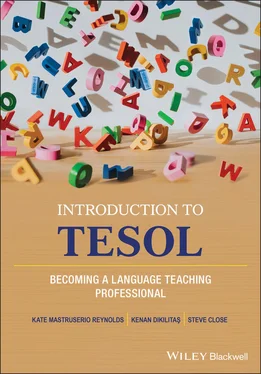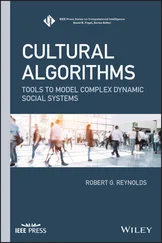The most common acronyms in the field to describe the study of English language by individuals who speak one or more other languages are ESL, EFL, EIL, and ELL. There are other acronyms for the study of English, such as VESL (vocational English as a second language), and content-based (CBI), sheltered instruction observation protocol (SIOP), which we will discuss later in the text.
ESL stands for English as a second language . It refers to language learning contexts, or locations, in which the majority of inhabitants speak English. Some English-dominant speaking countries spring to mind quickly, such as Australia, Canada, New Zealand, the United Kingdom, and the United States. In the field of TESOL, a shared value is that there is no “best” version of English; British English is not inherently better than the other variations of English. These countries have traditionally been considered the generators of patterns or norms of English language use. However, as the number of the speakers of English has increased over years, the English spoken by non-English speakers has also changed. This topic, World Englishes, will be covered in more detail in upcoming chapters.
Representing the different forms of English
In recent years, there has been a tendency to legitimize the English spoken by people coming from different first language (L1) backgrounds, which also implies that English as a second language and its dissemination is not necessarily kept under the control of countries speaking it as a first language such as England and America.
Other countries have many speakers of English because they were former colonies of an English-dominant country, but may also have many other languages spoken in the country (e.g., India, Nigeria, Pakistan, and the Philippines). There are many individuals in India, for example, who have spoken English all of their lives and who speak some of the 22 major languages spoken there. Interestingly, Indian English has elements of the native languages of the people infused into their English. This infusion affords flair and flavor to their language use. Additionally, Indian English speakers generate new patterns of language use in vocabulary, grammar, and pronunciation that are not necessarily influenced by their first language(s).
The acronym ESL implies certain perspectives. It suggests that students only speak one language when they might speak more than one. TESOL professionals often speak of “second language acquisition” to mean the process of learning or acquiring a second or additional language. Professionals in the field have suggested that we should use the term English as an additional language, which can be seen in some writings. In this text, you will see both terms employed.
Other issues exist with the use of “second language” as well. In the past, students learning another language often needed to travel to the target language country to practice their language with native speakers in order to develop a high degree of language proficiency. With the ease of global communication on the internet, students may have access to English in formerly unprecedented ways. They have access to newspapers, magazines, blogs, movies, music, and chatrooms with native English models of language. This access breaks down the distinction between “second and foreign language” contexts to some degree.
In spite of the issues noted above, ESL remains a widely used acronym. Many professionals use the term and keep these caveats in mind.
Heterogeneous or homogeneous learner populations
In some classrooms, there may be students who speak many different languages. For example, in New South Wales, Australia, there are 239 different languages spoken in the public schools as of 2018 (CESE Bulletin, 2018). Students may speak Chinese, Arabic, Vietnamese, Tagalog, Samoan, or Greek. We call this a heterogeneous class due to the different languages.
In other language settings, there may be classes with students who all speak the same language. This class composition is called a homogeneous population, because they share a similar first language. These distinctions are important, because the types of activities a teacher may use differ if they all share a language.
Generally, there are more heterogeneous class compositions in second language settings and more homogeneous groups in foreign language contexts. However, there are always exceptions to this pattern.
ESOL stands for English to speakers of other languages . The contexts for ESOL are similar to ESL—contexts where the language used outside of the classroom is English. This acronym was introduced to explicitly alleviate a problem, which was that the acronym ESL implied studying English as a “second,” not “additional,” language. ESOL implies students may speak more than one other language.
ESOL was adopted by several U.S. states in their laws and by TESOL International Association and its affiliates in their names. For example, Washington Association for the Education of Speakers of Other Languages (WAESOL) ( https://waesol.org) and Peru Teachers of English to Speakers of Other Languages ( http://www.perutesol.org).
EFL represents English as a foreign language. It describes the study of English in contexts where the language used outside of the classroom is not English. Often the language employed outside of the classroom is the students’ primary language. For example, the study of English in countries such as China, Japan, Saudi Arabia, Thailand, Ukraine, and the United Arab Emirates.
There are some inherent issues with the use of EFL. EFL is one of the older acronyms to describe the study of English. With the use of the world “ foreign ,” it has a negative connotation of otherness or oddity. In the field of TESOL, we hope to bridge cultural differences, so emphasizing otherness is counterproductive.
Despite the anachronistic nature of some of these acronyms, they do provide a clear distinction in context, which provides insiders with information about the amount of language practice and practice opportunities, and duration and type of instruction. For example, in Japan, elementary school children have English class for a couple of hours per week in which they learn basic vocabulary for families, food, hobbies through games and song. By middle and high school, students have English class daily, in which they learn speaking, listening, reading, and writing through choral drills, oral presentations, readings, interactive activities, and games. Much of the learning is about memorization and repetition. The classroom formats generally revolve around the teacher. The teacher asks a question and calls upon a student, for example. We call this teacher-centered interaction. For example, students in Japan may access outside-of-class opportunities to develop their oral language skills on the internet, but interaction within the community in English is not necessary, and often not even possible. Because of this and other factors, Japanese English learners tend to struggle with their oral language proficiency. This example is not intended to demonize the instruction of English in Japan. Actually, there are many exciting, culturally congruent practices employed by knowledgeable educators in Japan. These are generalizations to illustrate associations common with the EFL setting only. Although these are generalizations, generalizations are valuable at times.
English as an international language
EIL stands for English as an international language . It describes the study of English as it is used internationally. The term recognizes the use of English as a “lingua franca” or common language for communication. The concept of lingua franca will be further discussed in Chapter 4. EIL implies that English is used among individuals who may not be native speakers or bound to traditional native-speaker language norms. The contexts associated with EIL are in multilingual settings such as large, international cities (e.g., Hong Kong, Macau, Singapore, Doha, and Dubai) or on the internet.
Читать дальше












